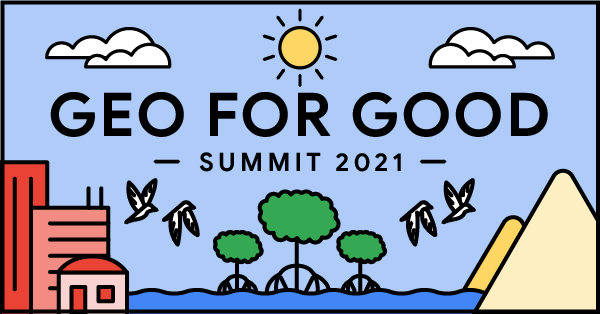by Annie Taylor

If you attended any of the Google Earth Engine workshops I've led with IGIS, then you know that I love talking about the tool and hearing what others are doing with it. Last month, I attended my fifth Geo for Good Summit, which is quite possibly my favorite annual event. I'll provide a recap of the event and some of my highlights, and then links for you to check out the summit for yourself or explore other resources.
Google's Geo for Good Summit is an annual conference where folks from nonprofits, government agencies, and scientists hear about the latest updates to Google's mapping tools and get to share their work with each other. Geo for Good, also abbreviated as G4G, has been held since 2012 and was an in-person Bay Area conference until 2020, when it was first held virtually. G4G continued in that virtual format in 2021, with some exciting twists on the usual virtual format.
G4G always kicks off with an inspiring community video that showcases different people and use cases, and this year was no exception.
Next, we got updates on the latest improvements to Google's geospatial tools, which is my personal favorite session. Here's a rough summary of my highlights.
What's new in Google Earth?
In case you haven't heard, Google Earth is now a gorgeous web application. Google Earth Pro (the desktop application) is still supported as they migrate all of its tools and functionality to the web version. There's also a mobile application for your phone! These updates relate to the web application:
- You can now export tile overlays from EE and import them into Earth so that they drape on top of the 3D planet – very cool visualization for your data.
- You can collaborate on Earth projects just like you would a Google Doc using the Cloud Project option.
- The date of the basemap imagery (when available) now pops up when you move your cursor. Also, the scale bar shows the scale bar relative to where your cursor is, which is a great addition for 3D viewing.
What's new in Earth Engine?
- Landsat and Sentinel images are now ingested and loaded into EE in under 12 hours from their capture – enabling near real time analysis in EE.
- The Dynamic World dataset – a global land cover probability map at 10m resolution available every five days from 2017 to 2021 – will soon be available in the EE Data Catalog.
- Additions to the API (new machine learning models)
- Additions to the Data Catalog and more Python API example scripts
Other Geospatial Tools by Google
I won't go into these here, so check out the recorded sessions for more information:
- Google My Maps
- Google Earth Studio
- Google Street View and Maps API
G4G was very creative in their approach to the virtual conference. For example, they organized poster sessions and virtual mingling in a custom space they created using Gather, where you could see and hear the people ‘nearest' to you in the ‘room.' They also hosted user-created Meet Ups, where members of the community can break off to talk about their specific application, tool, or part of the world. A final highlight of the conference were the Office Hours hosted by the engineers working on each of these tools, which is an incredible opportunity to talk through your specific idea or challenge.
If you missed it, you can find all of the recorded sessions on the conference website or on Google Earth Outreach's YouTube site, which are both linked below.
I hope to see you next fall at G4G 2022!
Annie
Conference Website (with recordings)
Geo for Good YouTube Channel Playlist
Earth and Earth Engine Blog
